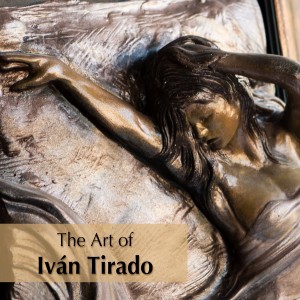Discarded Artwork

I am constantly sculpting or painting. I take a break from time to time but I try to sculpt or paint, or at least draw several times per week. I focus on one piece at a time while thinking about two or three more I want to create right after. At times I alternate between a sculpture and a painting working a little here and a little there. By the time I decide what my next show is about and how many pieces to present I probably have three times the amount of pieces ready. Only a certain amount make it to the exhibit. What happens to the other pieces? The discarded artwork might get rejected way before selection. Here are a few things that happen regularly in my little studio.
Let’s start with paintings. That’s the easier one since I don’t show that many paintings. If I like the painting in the first place it goes for sale almost immediately. If I’m not sure if I like it I hang it on a wall where I can look at it from time to time. I take pictures of it and pot them in social media. After sometime I might move it to the website for sale or I just set it aside to paint over it something different. When people talk about the mysteries of Leonardo’s multiple layers paintings I just laugh inside. If the painting falls under the theme or concept of the exhibit then I put it aside as part of the selection. In the event that it is sold before the show I send it to the new home unless the buyer wants me to show it. There are other possible destinations for a painting like donations or gifts. Technically no painting is discarded, just recycled.
Sculptures go to a slightly different process depending on the stage and medium used. Let’s begin with clay sculptures. First let me tell you about the stages of clay sculpting. I prepare the armature which is often just a simple wood stick on a wood board covered with newspaper. I sculpt and if I make it to the end without destroying it and starting over I let it dry. At that point I know I want to give the finishing touches and put it on a base. Again, if I really like it the piece goes for sale, if not it will be at the studio until I shatter it into pieces and throw it way. The piece if selected for an exhibit if it fits the theme, or it goes to group shows.
When sculpting with modeling clay the process is slightly different. I can start over the piece as many times as I want, as it happens many times. Once I’m done with the model I can still make changes or start all over again or simply develop the idea in a different direction. I’ve had ‘finished’ pieces in the studio for a year or more before moving on into creating a mold and casting the piece. Anything can happen during that time. I try to create a mold and cast only those I really like that either be part of the solo exhibit, go for sale, or being bought before casting as it had happened several times before. It is very unlikely that I go through the casting process of a piece I don’t really like. If any of those is discarded it remains at home.


A Tale of Two Sculptures
Last year during one of my shows, I observed a lady coming in to look at the artwork as I was talking to someone else. After looking at all the sculptures, she came back to Abased. She stood there for a while. Then she moved towards Freedom and stood there for a while. She went back to Abased, then back to Freedom. I observed while this continued for several minutes.
Abased & Freedom
Done with my conversation I approached the lady and introduced myself. I mentioned I was observing her going back and forth between the two sculptures. She mentioned how the sculptures were almost talking to her in a way she could not understand or articulate. I told the lady the definition of Abased (belittled or degraded). Instantly the conversation took an interesting turn. She said:
“That explains a lot. This is how my husband makes me feel (pointing at Abased) but I want to feel like that (turning and pointing at Freedom).”
Without saying another word, she turned away and left. I was stunned and honestly wished she stayed around longer. I was curious to find out more about what the sculptures were saying (figuratively speaking). Still, three things were clear during this short interaction. First, art has the power to speak to people. People can find a connection in art that generates a silent conversation with the soul, the logic, and the senses. No words are necessary for this connection.
On the other hand, some people need some help when they try to articulate that connection; when they try to understand what they see, what they feel, and what they perceive. While it is not necessary to explain some people seek for a deeper understanding, a hint, a spark that provides and explanation they can ponder. Again, it would be better for art never to be explained. Nevertheless, some people want to express their connection. That cannot be denied. Otherwise, we might be shutting down their interest and a great opportunity to provoke consciousness.
That takes me to the third point: expressing the connection could be the first step towards healing. Too bad the encounter was cut short. When someone understands their internal situation (and sometimes external) through art, and consciously expresses that revelation, healing is possible. Articulating what no words can explain (which not necessarily is a contradiction) could transform a life, and that is one of the most rewarding achievements of art.